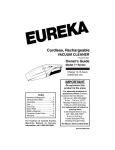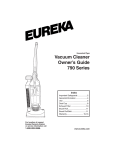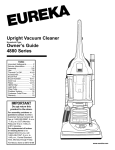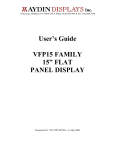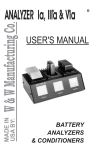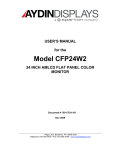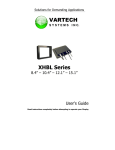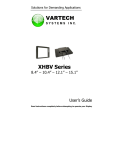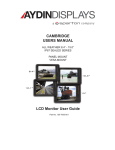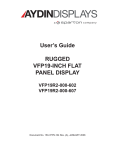Download CAMBRIDGE USERS MANUAL LCD Monitor User
Transcript
CAMBRIDGE USERS MANUAL ALL WEATHER 8.4” - 15.0” IP67 SEALED SERIES Military Grade PANEL MOUNT ARM MOUNT LCD Monitor User Guide Part No. 150-7000-002 Table of Contents Introduction............................................................................... 3 Safety...................................................................................... 4 Product Care and Maintenance.................................................... 6 System Set-up........................................................................... 8 Installation................................................................................ 9 Display Connections................................................................. 11 Computer Hook-up................................................................... 13 Operator Controls..................................................................... 16 On-Screen Display (OSD).......................................................... 17 Optional Touch Screen.............................................................. 21 Appendix A - Mechanical Drawings ........................................... 28 Appendix B - Troubleshooting.................................................... 28 Appendix C -Technical/Environmental Specifications..................... 31 2 150-7000-002 Welcome. The Aydin MIL-Spec Monitor is a ruggedized marine grade LCD Display for use with a conventional RGB computer input. It is designed to operate under the most extreme environments found in high performance vessels such as public safety, government and military marine craft, as well as submarine vessels. The ruggedized displays are capable of operating in environments that include extended temperatures, extreme shock and vibration, direct exposure to salt water and other environmental conditions. Housed in a milled billet aluminum case, the slim-profile model is light weight and watertight, with fully sealed, military grade connectors. Front-mounted controls and various mounting options makes this a user-friendly display. This model incorporates the latest optical engineering to achieve optimal viewability in all lighting conditions. It is engineered to operate on low power consumption, and may be equipped with optional Analog Resistive Touch Screen. This manual contains instructions for configuring the touch screen as well. 150-7000-002 3 Safety General Safety Instructions • Before operating this Monitor, read this User Manual thoroughly • Retain this User Manual for future use • Verify the computer system capability (see System Set-up) to insure operation of the Monitor • For expeditious installation, follow these User Manual instructions in the sequence presented • Adhere to all Caution and Warnings on system parts and as stated in this User Manual • All User Manual instructions for installation and operation must be followed precisely • Adjust only those controls covered by the User Manual’s operating instructions; improper adjustment of other controls voids the unit’s warranty and may result in unit damage, and • Adhere to local installation codes. Safety Icons warning! caution! Warning! Shock Hazards This icon is intended to tell you of a potential risk of electrical shock. Caution! Instructional This icon is intended to tell you of important operating and/or maintenance instructions. General Unit Safety • Always disconnect the unit from the power source before cleaning • Do not operate the unit with a damaged cord • Do not operate if the unit has been dropped or damaged. The unit needs inspected by qualified Aydin Service Personnel • Position the power cord so it shall not be in contact with hot surfaces • Do not allow anything to rest on the power cord, and • Do not place the power cord where there shall be foot traffic. General Safety Precautions warning! • Power cord must be connected to a properly wired and grounded power source • Any equipment to which the unit shall be attached must also be connected to properly wired and grounded power sources • Do not connect or disconnect the unit during an electrical storm • Do not remove the unit covers – there are no user serviceable parts in the unit • Do not disassemble or modify the unit to avoid the possibility of electrical shock, damage to electrical components or scratching the Display surface, and • Disassembly of the unit voids the warranty. 4 150-7000-002 Fluids from LCD Display caution! • If the Monitor should ever become shattered, do not touch fluids from an LCD Display • If fluid should get on hands or clothing, immediately wipe off with liquid soap or rubbing alcohol; wash with water; consult with a doctor, and • If fluid gets in the eyes, flush eyes immediately with water for a minimum of 15 minutes; consult with a doctor. Electrical Safety Connecting Cables • Disconnect the power to the computer when the Monitor is being installed, and • Upon installation, verify the power connector is securely seated on the unit. Ratings and Grounding This unit may be operated from an 8-36 VDC power source. • Use the supplied power cable, and • Always connect to a properly grounded power source. Protection on Servicing Servicing - User • User care is limited to cleaning the exterior of the unit. • Do not disassemble or modify the unit or cables to avoid the possibility of an electrical shock, damage to electrical components or scratching the Display surface, and • Disassembly voids the warranty. Servicing Aydin Displays Qualified Service Personnel may be required if the unit: • Does not operate normally when installation instructions are followed • Does not operate normally when operating instructions are followed • Has been dropped or damaged, or • Exhibits a distinct change in performance, indicating a need for service. Shipping If the unit should need to be shipped to the Aydin Displays Service Center, the original packing material should be used to insure safety in shipping. Repack the unit as it would have originally been received from Aydin Displays. caution! Radio Frequency Interference This equipment generates, uses and can radiate radio frequency energy. If not installed with the unit’s accompanying cables, it may cause harmful interference to radio communications. 150-7000-002 5 Product Care and maintenaNCE Product Care This monitor has been designed to provide optimum performance and service without any required scheduled maintenance other than occasional cleaning. warning! caution! Turn off the Monitor power before cleaning the Monitor, optional Touch Screen or unit’s enclosure. • Do not use abrasive cleaners or solvent-based (flammable) cleaners on the Flat Panel or Touch Screen Display, its enclosure or any other electrical device (cables, power cord, etc) • Do not use paper products as they may scratch the Display screen, and • Do not directly apply cleaning solutions to the Display screen. Display Screen Cleaning • A vinegar-based cleaner is preferred to prevent streaking and degradation of the coatings, or • A non-abrasive glass cleaner such as a professional foam glass cleaner • Apply the cleaning solution to a soft clean cloth, dampening slightly • Keep a fresh side of the cleaning cloth towards the screen surface to avoid scratching it with accumulated grit, and • To minimize the risk of abrasion to the screen, air drying is recommended. In marine or similar environments, an added benefit of a vinegar-based cleaner is its effectiveness in dissolving salt deposits. Optional Touch Screen warning! Disconnect cabling from the Touch Screen Display before cleaning. A Touch Screen Display will be activated by cleaning the Display. This may create a potentially dangerous condition. Optional Touch Screen Cleaning • Follow cleaning directions above, or use a special screen cleaning tissue or a solution specifically formulated for antistatic coatings. • Lightly dampen a soft clean cloth with water, vinegar based cleaner or a general purpose mild detergent solution • Keep a fresh side of the cleaning cloth towards the screen surface to avoid scratching it with accumulated grit, and • To minimize the risk of abrasion to the screen, air drying is recommended. Monitor Enclosure • Clean the unit enclosure with a soft clean cloth lightly dampened with a general purpose mild detergent solution • To rinse, wipe down with clean water, and • Dry with a soft clean cloth. 6 150-7000-002 warning! To avoid risk of electrical shock, do not disassemble the unit’s enclosure. Users cannot service the Monitor. User maintenance is restricted to cleaning, as explained. Disassembling the unit voids the warranty. Long-term Storage • For long-term storage, it is suggested the unit be stored in a normal indoor environment and the Display glass be protected from accidental damage. • For pedestal mount units, disconnect the cable(s) and loosen the arm adjustment to a point where the ball can be removed from the arm, or • For Flush or Panel Mount units, cover the product with a protective covering that shall not scratch or transfer any dyes to the Display screen. Maintenance warning! Power Cord To avoid shock and fire hazards, replaced the unit’s power cord if: • Insulation becomes damaged, or • A loose connection is suspected. Other Maintenance Only Aydin Qualified Service Personnel shall perform all maintenance except for the power cord replacement described above. 150-7000-002 7 SYSTEM SET-UP System Requirements The computer must have this capability: 8.4=800 x 600 (SVGA) 10.4=1024 x 768 (XGA) 12.1=1024 x 768 (XGA) 15.0=1024 x 768 (XGA) • If the optional Touch Screen Display is ordered, an available COM port for the connector is required. Shipping Box Contents The display is shipped in a custom box with custom foam packaging. We recommend you save the box and all packaging materials in case the unit would need to be returned to the Aydin Displays Service Center. In the shipping box you shall find: • • • • • • • CFP 8.4, 10.4, 12.1 or 15.0 Custom Power Cable Custom VGA Cable Mounting System and Hardware Touch Screen Cable if the optional Touch Screen is ordered USB Cable if the optional USB Pass-through is ordered, and Optional Touch Screen Drivers (located on Aydin website) Figure 1 8 150-7000-002 Installation The display is designed to be mounted with a universal ball-and-socket mounting kit, in a flat panel or optional flush mount configuration. Optional Pedestal Mount The display can be supplied with a RAM® universal ball-and-socket system mounting kit (Figure 2). By installing the monitor with this kit, the user can quickly adjust the viewing angle to improve viewability in changing environments. This ball-and-socket system has proven to be successful in supporting an extreme amount of weight in high vibration and difficult-mount applications. Locate the ball-and-socket system in the shipping box. The kit consists of two RAM balls on mounting plates and a RAM arm, with an adjustable T-knob and a packet of three (3) M4 x 10 counter-sunk stainless screws for mounting to the display. Mounting Holes Figure 2 Figure 3 Figure 4 150-7000-002 9 There are three mounting holes in the back of the Monitor for the ball mounting plate. Take care not to strip the screw holes or over tighten. (Figure 4) • Line up one of the ball mounting plates on these three holes (Figure 4) • With three (3) M4 x 10 counter-sunk stainless screws attach this mounting plate to the back of the unit. • Mount the second ball mounting plate where the Monitor shall be installed • Insert each ball into the RAM arm • Lightly tighten the arm around the balls using the T-knob on the arm (Figure 2, 4) • Adjust the Monitor to the viewing preference, and • Tighten the T-knob to hold the Monitor in position. It is recommended the remaining ball be mounted on a flat surface. Because of the various surface substrates the Monitor shall be mounted on, the installer shall provide the screws to mount the other ball. Panel Mount The panel mount installation should be specified at the time of order; the ball-and-socket mount system will not be included in the shipping box. The mounting hardware packet is included with the unit accessories in the shipping box. This packet includes four (4) threaded screws (approximately 7.6 cm [3”] long), four (4) Nylock nuts and four (4) flat washers. For installation, there are four tapped mounting holes on the four corners of the unit’s rear panel. caution! Take care not to strip the screw holes or over tighten as the enclosure is aluminum. Figure 5 10 150-7000-002 DISPLAY Connections Connectors Use care when inserting or removing connector. Do not force their mating. Caution! There are two (2) MIL-DTL connectors on this model: Power Input and Video Input. (Figure 6, 7). Connectors are located on bottom of Display housing. From left to right: Power Input, a 3-Pin Connector and Video Input, a 13-Pin Connector. 1 Power Input 2 Video Input 1 2 1 2 Figure 6 Figure 7 Power Input The Power Amphenol Connector is a MILDTL-26482 Series I Connector. • End User supplied or Optional Power Cable • 3-Pin Connector pin-out is listed in Table 1 • Line up with Connector # 1 in Figure 7 • Add a twist to lock. Power cable 3-pin plug MIL-C-26482 SERIES I PIN SIGNAL A 28 VOLT DC B 28 VOLT RTN C CHASSIS_GND AMPH 71-533721-33P MATE PT06E833SSR Table 1 Power Consumption Warning! The 8.4”, 10.4”, and 12.1” are listed at 20 watts. The 15” is listed at 35 watts. 150-7000-002 11 Video Input The Video Amphenol Connector is a MIL-DTL-38999 Series I Connector. See Table 2. • End User supplies Video Cable • 13-Pin Connector pin-out is listed in Table 2 • Line up with Connector # 2 in Figure 6 • Add a twist to lock. Video cable 13-pin plug MIL-DTL-38999 SERIES I PIN SIGNAL 1 Red Video Signal 2 Red Video Ground 3 Green Video Signal 4 Green Video Ground 5 Blue Video Signal 6 Blue Video Ground 7 H-SNYC 8 V-SNYC 9 H/V SYNC Ground 10 USB+/RS-232 RXD 11 USB-/RS-232 TXD 12 Digital Ground 13 RI-OUT AMPH 88-569722-35P MATE MS27467E11B35S Table 2 12 150-7000-002 Computer hook-up Computer Display Properties - XGA or SVGA Prior to connecting the monitor to the computer, with another monitor, verify the computer display properties are set to between 640x480 and 1024 x 768 in 4:3 aspect ratio. caution! • The optimum setting for viewing is 800 x 600 (8.4”) or 1024x768 pixels (all other sizes). • The refresh rate must be set between 60-75Hz to eliminate screen flicker. • Pixel settings different from the native resolution may exhibit less precise images, and • Pixel settings over 1024 x 768 flash “out of range”, with no display. Setting the Display Settings 1. Right mouse click on an open area of the desktop screen to bring up the Desktop Menu. 2. Left mouse click on Properties to open the Display Properties menu. 3.Connect to a CRT monitor to establish the computer display properties. 4. Select the Settings tab. 5. Under Screen Resolution, verify or slide the bar until the Screen Resolution is at 800 x 600 pixels (SGVA) or 1024x768(XGA). 6. Select the Advanced button to go to the next menu to verify the Hz refresh rate. 150-7000-002 13 7. Select the Monitor tab. 8. Under Monitor Settings, verify the Screen Refresh Rate is between 60 and 75Hz. •If so, select the Cancel button and go to step 9. •If not, select a setting within the 60 – 75Hz range •Select the Apply button. 9. At the Monitor Settings dialog box, select “Yes” to accept the new desktop view settings. 10. In the Display Properties dialog box, verify the Screen Resolution is at 800 x 600 (SVGA) or 1024x768 (XGA). 11. Select the Apply button. 14 150-7000-002 Signal Quality •The strength of the video signal provided to the display has a direct bearing on the quality of the images displayed •The cable supplied with the unit shall provide the optimum image if proper wiring practices are followed •Install the cable properly and keep it away from sources of EMI such as electric motors, or unshielded RF sources such as radar and microwaves •Splitting the video signal also splits the strength of the signal •If your installation requires more than one Monitor to be driven from a single video source, it is highly recommended that a video signal booster (line driver) be used in the circuit, and •Some splitters are available with an integral line driver. Whether or not a line driver is used, single cable lengths in excess of our standard cable length should be of high quality shielded VGA cable. Power on the Monitor • The Windows Operating System should automatically apply the best generic driver for this connection, and • Follow the instructions under section Computer Display Properties for optimum display quality. 150-7000-002 15 operator controls On the right hand side of the Monitor bezel are seven Operator Control buttons. Power Button Note: Monitor defaults to an AUTO-OFF state when power is applied. •The Power On/Off button is marked with the I/O (Input/Output) symbol •Momentarily pressing this button shall turn ON or turn OFF the unit, and •Blue LEDs glow behind the buttons when the unit is powered on. Power On/Off (I/O) Button Brightness Control Toggle (large sun, small sun) Select Button Up Button Optional Feature: Monitor defaults to an AUTO-ON state when power is applied. This feature must be ordered when the Monitor is ordered. It is not an add-on after the unit is built. Down Arrow Source Select Button Brightness Toggle This toggle controls the brightness of the LCD Panel Display. •The large sun toggle side, when repeatedly pressed or held down, shall cause the Display’s backlight brightness to increase •The small sun toggle side, when repeatedly pressed or held down can be stepped down in increments to the lowest setting, which is just above total black and suitable in very subdued light, as in night time operations, and •The Monitor shall revert to a mid-range setting when the unit is powered off. Adjust the brightness of the Display to the lowest possible setting for a given set of conditions and display characteristics. Doing so shall provide the best viewing of the image, extend the lamp life of the backlight and reduce the internal heat of the Display. Select Button The Select Button is the access point to the On-Screen Display (OSD) Source Screen Menu. (See On-Screen Display.) Up Button The Up Button is an adjustment tool in the OSD Source Screen Menu. (See OSD Screen Menu Parameters.) Down Button The Down Button is an adjustment tool in the OSD Source Screen Menu. (See OSD Screen Menu Parameters.) Source Button The Source Button allows the user to switch between video signal sources attached to the Monitor – Composite Video 1, 2 & 3, and VGA. 16 150-7000-002 on-screen display The On-Screen Display (OSD) user interface is the path to all display signal source adjustments. The Source Screen Menu, with its user-friendly graphical interface, provides access to fine-tuning the Display. OSD Source Screen Menu Activation To activate the OSD menu in the current video source, press and release the SELECT button. Note: OSD Source Screen Menu shall close after 15 seconds of inactivity. This setting can be adjusted in the OSD Source Screen Menu (OSD Menu icon), under OSD Duration. OSD Source Screen Menu Parameters The Source Screen Menu is comprised of six icons, each representing distinct source screen categories and their corresponding functions menu with adjustable settings. Picture Menu Source Menu OSD Menu Set up Menu Inactive OSD Tools Menu Parameter Adjustments • To choose a Display Parameter Category, use the UP (right) or DOWN (left) buttons to move across the Source Screen Menu • As each Category icon is highlighted, its related Functions Menu appears in a drop-down box • To activate a Display Parameter Category, move the highlight box over its icon and single press the SELECT button • In the Functions Menu, a highlight bar is superimposed over the first function • Press the UP or DOWN buttons to move the highlight bar through the related Functions Menu • Single press the SELECT button to choose a Related Functions Menu item when it is highlighted • A smiley face appears to the left and a new color bar appears on the Function, indicating the Category is active; its parameters can be adjusted • The adjustment controls are the UP and DOWN buttons, which increase or decrease the value of the parameter as noted in the percentage bar • Create the new parameter value • Single press the SELECT button to save the new value; this returns the user to the Source Screen Menu • Exit from the Function Menu • To choose another Display Parameter Category, use the UP (right) or DOWN (left) buttons to move across the Source Screen Menu and follow the above instructions, or • Single press the SELECT button again to exit from the OSD Source Screen Menu, or • Close the main menu; all changes are saved. 150-7000-002 17 OSD Source Screen Menu Parameter Selections • New settings shall be stored in memory upon pressing the SELECT button to exit the Source OSD Source Screen Category’s Function Menu. • If SELECT is not pressed, or inactivity is detected within the 15 second factory default OSD duration, any function adjustments made shall not be saved. caution! It is recommended to adjust the LED back light brightness to maximum before fine-tuning the OSD Source Screen Menu Picture Menu Parameter: Brightness. Picture Menu Parameters Brightness Before adjusting the Brightness function parameters, set the LCD panel backlight brightness using the control toggle (large sun/small sun); set to its brightest (large sun button) in the ambient light source. •Open the “Brightness” function •Press the UP or DOWN buttons to set the Display’s desired brightness, and •Adjustments go from very dim (black) to 100%, very bright (dazzling white). Contrast Contrast is the difference in brightness between the light and dark areas of the pixels of a picture. •Open the “Contrast” function •Press the UP or DOWN buttons to set the Display’s desired contrast, and •Predefined minimum to maximum is in the display bar. Saturation Saturation is the vividness or intensity of the hue or color. •Open the “Saturation” function, and •Press the UP or DOWN buttons to set the Display’s desired saturation. Tint Tint is the pinks, blues and greens of the Display. •Open the “Tint” function •Press the UP or DOWN buttons to set the Display’s desired tint, and •Ranges on the Display bar are: low – pinks; mid-range – blues and upper – greens. Sharpness •Open the “Sharpness“ function •Press the UP or DOWN buttons to select a desired sharpness for the Display, and •Sharpness choices in the Display bar are preset at - 0, 33, 66 and 100%. Auto Color •Auto Color is best calibrated from an all-white background. From the VGA video source, create an all-white background •Open the “Auto Color“ function •Press the SELECT button to run the Auto Color Setup. Repeat twice, and •When complete, press the SELECT button to save the changes and exit. 18 150-7000-002 Source Menu Parameters A check in a box indicates an enabled signal source attached to the monitor. Deselecting the box disables the monitor’s ability to display the signal. Video 1 - Composite •Open the “Video1“ function, and •Press the UP or DOWN buttons to enable (ON) or disable (OFF) the Video 1 source. Video 2 – INACTIVE or, if connected, as above. Video 3 - INACTIVE or, if connected, as above. PC - VGA •Open the “PC“ function, and •Press the UP or DOWN buttons to enable (ON) or disable (OFF) the PC source. OSD Menu Parameters OSD H-Position •Open the “OSD H-Position” function, and •Press the UP or DOWN buttons to adjust the horizontal position for the OSD menu on the Display. OSD V-Position •Open the “OSD V-Position” function, and •Press the UP or DOWN buttons to adjust the vertical position for the OSD menu on the Display. OSD Duration •Open the “OSD Duration“ function, and •Press the UP or DOWN buttons to adjust the time elapse between the last menu activity and when the menu disappears. The range is between 0 and 100 seconds; factory default is 15 seconds. Set-up Menu Parameters AUTO Power •Select “AUTO Power” function if user wants system data (channel, signal source) saved when the system is powered off. Reset •Select “Reset“ function, and •Select “YES” to automatically adjust picture data to default such as: brightness, 150-7000-002 19 contrast, saturation, tint and sharpness. System •Select “System“ function to select the source signal type: NTSC, PAL and AUTO •Video 1 - Composite - NTSC •Video 2 - Inactive •Video 3 - Inactive •PC – RGB, and •AUTO - Recommended selection. Automatically assigns the correct video signal source association. TV Category Parameters - Inactive Screen Menu Parameters NOTE: Source Screen Menu Category is enabled when the input signal is VGA. H-Position •Open the “H-Position” function, and •Press the UP or DOWN buttons to adjust the horizontal position of the screen display. V-Position •Open the “V-Position” function, and •Press the UP or DOWN buttons to adjust the vertical position for the screen display. Phase •Open the “Phase” function, and •Press the UP or DOWN buttons to adjust phase (analog to digital) for the screen display. Clock •Open the “Clock” function, and •Press the UP or DOWN buttons to adjust clock (horizontal stretch) for the Display. 20 150-7000-002 optional touch screen Optional Touch Screen Installation caution! If you are installing a new operating system (O/S), do not install the Touch Screen Controller Driver CD until you have installed the O/S and verified the computer’s monitor display is working properly. The Touch Screen Controller Driver uses the computer’s O/S display driver software settings to accurately configure the Touch Screen Controller Driver files. Previous Versions of Touch Screen Controller Drivers caution! Previous versions of ANY Touch Screen Controller Driver must be removed before installing the latest version of the TSHARC™ Touch Screen Controller Driver. Uninstall TSHARC Utility Uninstall a Previous Version of TSHARC The uninstall utility “TSUN10.exe” is included on the TSHARC Touch Screen Controller Installation CD, in the shipping box with the product accessories. This utility uninstalls TSHARC drivers only. From the Product CD To uninstall: install the CD > go to My Computer (desktop) > Left double mouse click > Locate the drive with the Installation CD > Left mouse click to open > Left double mouse click on the Uninstall Drivers folder > Left double mouse click on “TSUN10. exe” to execute the uninstall utility > Follow the instructions. Note: The dialog box stating it is removing all Touch Screen Drivers from the computer means it is removing all TSHARC drivers. Other Touch Screen Drivers must be uninstalled with their manufacturer’s uninstall utility. From the Aydin Website Go to: www.aydindisplays.com navigate to Customer Service, then Touch Driver Downloads Note: The dialog box stating it is removing all Touch Screen Drivers from the computer means it is removing all TSHARC drivers. Other Touch Screen Drivers must be uninstalled with their manufacturer’s uninstall utility. 150-7000-002 21 Uninstall a Previous Version of Other Touch Screen Drivers If a version of a different Touch Screen Controller Driver (not TSHARC) is on the computer, it must be completely removed before installing the TSHARC. Note: The typical driver uninstall program or Microsoft’s® remove program utility does not remove all tracks of the Touch Screen Driver program. Contact the manufacturer of the previously installed driver program to learn how to completely uninstall their product. These instructions may be available from the manufacturer’s web site. Touch Screen Installation TSHARC Touch Screen Controller Driver A TSHARC Touch Screen Controller Installation CD is included in the shipping box with the product accessories. The driver is compatible with these O/S: Windows® 98 SE (Second Edition), ME, 2000 and XP. caution! Before loading Touch Screen Controller drivers, verify the COM ports are enabled (especially if using a laptop computer). Installation 1.Attach the RGB/Touch Screen Cable to the connector 2 2.Attach the Touch Screen Cable RS-232 connector to a computer serial port, or 3.Attach the Touch Screen Cable USB connector to a computer USB port. Note: For Multi-monitor applications, all Touch Screens must be connected to the computer before installing the TSHARC driver. caution! • If installing RS-232 connectors, the driver has to be installed for each Touch Screen, or • If installing USB connectors, the driver is installed one time for multiple Touch Screens. • If the Touch Screen connector is USB, Window shall load a temporary USB driver. Wait for the driver to load. 1.Boot up the computer 2.Insert the TSHARC Controller Driver CD 3.On the desktop, left double mouse click on the My Computer icon 4.Locate the drive with the TSHARC Touch Screen Controller Drivers Installation CD 5.Left mouse click to open 6.Left mouse double click to open the Resistive Touch Driver file 7.Left mouse double click to open the file for 2000, XP, 98, ME O/S, and 8.Left mouse double click to run “set-up.exe”. 22 150-7000-002 TSHARC Installation caution! If you need to cancel this driver installation at any time, select the Cancel button on the driver installation dialog screen. 1.At the Welcome screen, select Next to go to the Software License Agreement (EULA) 2.After reading the EULA, if in agreement, check the box “I accept all of the terms…” 3.Select Next. Note: Any unlawful use of the TSHARC driver is a strict violation of the United States and International copyright laws. Using a TSHARC driver with any third party Touch Screen is strictly prohibited. Select Controller 1.The TSHARC Driver is a 12-bit controller; the radio button is selected by default Note: A PS/2 controller interface is not available. 2.Select the controller interface matching the cable used to install the monitor 3.Select the Autodetect button if installing the Touch Screen through a RS-232 (serial) interface 4.There are two options for RS-232 installation: Autodetect and Manual. Manual instructions are found in section Manual RS-232 Controller Set-up 5.If connecting through a USB interface, select the USB radio button 6.Select Next 7.Following installation, select Finish, and 8.Reboot the computer when prompted. Autodetect RS-232 Controller Set-up 1.Select the Autodetect button 2.The “AutoDetect Serial” dialog box lists the detected RS-232 controller information. Select OK 3.“Installing Touch Screen Driver” text box pops up, indicating the progress of the installation 4.Following installation, select Finish, and 5.Reboot the computer when prompted. 150-7000-002 23 Manual RS-232 Controller Set-up 1.Select the Controller Interface RS-232 radio button 2.Select Next Note: Do not select Autodetect 3.Follow the instructions, entering the COM port selection 4.The Touch Screen Controller baud rate default is 9600 Note: Capacitive Controller option is not available. 5.Select Next 6.Following installation, select Finish, and 7.Reboot the computer when prompted. TSHARC Calibration Program Upon reboot, the Touch Screen is functional, but not calibrated. Calibration must be configured for the Touch Screen to work properly. The TSHARC Control Panel initiates the calibration process. • Go to Start > Programs > Hampshire TSHARC Control Panel. The Control Panel has five tabs. Each tab provides links to tools that can modify the TSHARC Drivers to meet specific needs. • Touch Screen Display Selection • Calibration • Click Settings • Touch Settings • Capacitive Settings TSHARC Control Panel Screen Selection Note: If this is not a Multi-monitor installation, skip to section Calibration. Configuring a Multi-monitor Installation Note: Microsoft does not support a Multi-monitor installation in Win98 SE. 1.The controller installation program opens to the Screen Selection tab. Note the graphic representation of the Monitors installed on the system 2.Using the keypad or the mouse, select the Monitor to calibrate 3.Switch to the Calibration tab. Go to the next section: Calibration 4.When complete, return to the Screen Selection tab; select the next Monitor. Repeat the process until all Monitors are calibrated. 24 150-7000-002 Calibration The calibration process aligns the Touch Screen overlay to specific points on the Display screen. 1.Select the Calibration tab or, in ten seconds, the calibration program launches, unless a Multi-monitor situation is present, then go to section Configuring a Multi-monitor Installation 2.There are three buttons: Graphic, Calibration and Test. For default Four-point calibration, select the Graphic square. This is the best known general calibration; it compensates for skew and some edge linearity anomalies, and 3.Go to section Calibration Process. Custom Calibration Settings 1.To customize the calibration process, select the Calibration button to bring up Calibration Options and the Offset menu 2.Select OK when calibration and/or offset selections are made: • Three-Point Calibration: Quick calibration of a known good Touch Screen overlay. No correction is applied • Four-Point Calibration: Compensates for skew and some edge linearity anomalies • Seven-Point Calibration: More accurate than three-point calibration. No correction is applied • Twenty-Point Calibration: Provides the highest level of Touch Screen linearization and skew correction, and • Offset: Varied linearity exists between Touch Screen types; user may want to calibrate the edges of the Touch Screen more precisely. Default is 20%. Calibration Process 1.Press the Center Graphic to start calibration 2.Targets are used to calibrate the Touch Screen. Follow the on-screen instructions - “Touch” the target center, “hold” until it shrinks, then “release” the target, and 3.Repeat the process for all targets. Note: the calibration screen shall time-out and return to the Calibration tab if the first point is not touched within 10 seconds. Calibration Verification Test 1.Touch the screen in several places to verify the calibration target is displayed under the finger, and 2.Select the Accept button to apply and record the calibration data. Note: If the calibration target is not displayed under the finger, select the Cancel button, repeat Custom Calibration Settings, then Calibration Process. 150-7000-002 25 Calibration Drawing Test 1.Select the Test button on the Calibration tab 2.Using a finger or stylus, draw or write, and 3.Observe if the screen displays the drawing accurately. If it does not, repeat the Custom Calibration Settings and Calibration Process instructions 4.Select the Quit button to exit the test. Click Settings Right Click 1.If desirable for Touch Screen application, check the “Enable Right Click” box to set the right click option Right Click Area 2.Use the slide bar to set the Touch Screen event area to a size slightly larger than the activator – larger for a finger tip, smaller for a stylus; the box displays the activator size Right Click Delay The timed-hold right click mouse event allows the user to initiate a right click by holding down a touch point for a specific period of time. 3.Use the slide bar to set the Right Click Delay value to the time necessary to produce a right click event Double Click Area This step sets the area that shall allow for a double click event. Limit this to areas that can be accurately touched several times. 4.Use the slide bar to set the double click area; the box displays the activator size Double Click Speed 5.Use the slide bar to set sufficient time to perform a double touch in the specified area 6.Select the Apply button to enter the selection, and 7.Select the OK button to apply all Click Settings. Touch Settings 1.Normal: Emulates a standard mouse, allowing a single click, double click, drawing, dragging and right click option (if enabled) 2.Touch Down: Allows for a click event to take place at touch down. No draw or drag is available 3.Touch Up: Touch only. Double click is disabled. If right click was earlier enabled, it shall be disabled. Touch Sound 1.Check the Enable Touch Sound to enable a tonal beep when the screen is touched 2.Select the Apply button to enter the selection, and 3.Select the OK button to apply all Touch Settings. 26 150-7000-002 Capacitive Tab – Disabled The Touch Screen is a resistive type; the Capacitive Tab shall be disabled. Touch Screen Tray Icon 1.If you do not want a Touch Screen Controller Icon to display in the toolbar tray, go to step 3, or 2.If you want a Touch Screen Controller Icon to display in the toolbar tray, select the box, and 3.Select the Finish button; the TSHARC drivers shall be installed. Installation Complete 1.At the dialog box, “Setup is now complete”, select OK, exiting the TSHARC Touch Screen Controller installation 2.The display touch is now active! 150-7000-002 27 APPENDIX A Mechanical Drawings Mount diagrams and its dimensions may assist you in installation of the Monitor. You may find them on our website at: http://www.aydindisplays.com navigate to Marine/Bridge/COTS Displays Mount diagrams of the optional Flush Mount Bezel and its dimensions may assist you in installation of the Monitor. You may find them on our website at: http://www.aydindisplays.com navigate to Marine/Bridge/COTS Displays Appendix b Display Symptom: No light behind button LEDs Possible Problem Solution No power, loose power connection Confirm the Monitor is properly connected to a DC or AC power source. Verify the power source is live or try another battery or AC power outlet. Verify the Monitor is powered on. Reverse Polarity Check polarity of the power connection. Symptom: Light behind button LEDs, no display, or “No Signal” error message and/or no image on the display Possible Problem Solution Power on, no video signal Verify the video cable is plugged into the VGA video connector. Verify a video signal is coming out of the computer (i.e., plug into a known good display source). Verify the incoming signal source selected matches the Monitor signal source (Composite, S-Video, VGA). Check the Brightness front panel setting on the Monitor. This may be set too low. Check the Brightness and Contrast controls in the OSD. These may be set too low. Computer may have gone into power management stand-by. Press any key on the keyboard, move the mouse or cursor, or it there is the Touch Screen option, touch the screen to wake up the computer. 28 150-7000-002 Symptom: Display has rolling “bars” across the screen or vertical shaded bars on the image. Possible Problem Solution VGA video display is not set to view at 800 x 600 pixels, or 1024x768 pixels. Verify the computer video display settings of the signal are set to match the display and 60 - 75Hz refresh rate. Defective video cable On a known good display source, confirm the video cable is not defective. Interference from adjacent equipment For proper grounding and shielding, verify use of a proper video cable. Keep the cable away from sources of EMI such as electric motors, or unshielded RF sources such as radar and microwave. Horizontal size is not adjusted In the OSD, adjust the horizontal size controls. Symptom: Picture quality, image stability is distorted. Possible Problem Solution Not working in 800 x 600 or 1024x768 pixel resolution Press the arrow down button one time to auto adjust the display. Verify the video display settings match the monitor, and 60 – 75Hz refresh rate. Proper cable grounding and shielding Verify the use of a proper video cable with suitable grounding and shielding. Keep the video cable away from sources of EMI and RF. Improper video display settings Check signal source for proper signal. Check for proper display properties selection of the display pixel setting. Verify the display refresh rate: 60 – 75Hz. Display unit is farther than 3 m (10 ft) from signal source Single cable lengths should be of high quality shielded VGA cable. Contact Aydin for information on custom cables. Multiple Monitors are driven from the same signal source. Splitting the video signal divides the strength of the signal. A video signal booster (line driver) is recommended if installation requires more than one Monitor driven from a single video source. Monitor has incorrect or bad sync signals. Check for proper video cable installation, or replace suspected faulty cable. Check the video source is within the display’s operating range: max. 1280x1024 pixels, and 60 – 75Hz. 150-7000-002 29 Symptom: Display image is not properly sized Possible Problem Solution OSD adjustments need to be made Adjust the vertical and horizontal size controls through the OSD. Improper video display settings Check for proper display properties selection of the display settings. Monitor autosize will only display full screen if source is 4:3 aspect ratio. VGA signal source “Auto Adjust” needs activated The VGA source is able to auto adjust the Monitor to its optimum viewing setting. Press the arrow down button one time to auto adjust the display. Symptom: Touch Screen (T/S) does not respond Possible Problem Solution T/S cable is not plugged in Verify the connections between the T/S and the computer. T/S cable is installed in a different COM port than installed by the software Install the T/S into another COM port. If using a laptop, verify the COM port(s) is enabled. T/S controller driver has not been installed Install the TSHARC controller driver. Hardware failure Contact an Aydin Technical Support Technician (610-404-5370). Symptom: T/S moves, but does not follow a finger or stylus Possible Problem Solution Controller is not calibrated Run the calibration in the TSHARC Control Panel software. T/S Controller Driver is not installed Install the TSHARC Controller Driver. T/S cable is not installed correctly Verify the T/S cable is installed correctly. Symptom: “Error in Calibration” message appears Possible Problem Solution The T/S Controller Driver is not installed correctly Uninstall the driver using “TSUN10.exe”. If a previous T/S Controller Driver was installed, all footprints must be removed. Go to the T/S manufacturer’s web site or contact the manufacturer for instructions to uninstall drivers. Reinstall the TSHARC Driver software. 30 150-7000-002 Appendix C Technical Specifications 8.4” Display Sunlight Readable TFT AM, SVGA, LCD, 262K Colors. 800 x 600 pixels 10.4” 12.1” 15” OPTIONAL 1024 x 768 XGA Display OPTIONAL 1024 x 768 XGA Display 1024 x 768 XGA Display Standard: 1400 nits NVIS : 1000 nits MIL-L-85762A (AF-Open Canopy) Dimming Ratio 1000:1 Video Input RGB 35 Watts Max Video Input Amphenol: Connectors MIL-DTL-38999 Series I Power Input Amphenol: MIL-C-26482 Series I Milled AL; Black Hard Anodized: Housing Mounting Wide Range DC Power Input Power Consumption Power Conditioning SAE AMS 2469 E Other Coatings: MIL-C-22750 RAM Mount (Standard) Flush, Panel, 19” Rack (Optional) 8-36 VDC (12, 24, 28 VDC nominal) MIL-STD-1275D 6 Watts Min - 6 Watts Min - 20 Watts Max Internal Short Circuit Protection Load Dump Protection Over Voltage Protection Reverse Polarity Protection 150-7000-002 31 Environmental Specifications 8.4” Operating Temperature -40°C to 70°C (-40°F to 158°F) MIL-STD-810F: 501.4/502.4: II-Op 10.4” 12.1” 15” Storage Temperature -40°C to 75°C (-40°F to 167°F) Shock 50 G Vibration 5.8 G (5-500 Hz) Altitude 45,000 ft. IP Rating IP67 (NEMA 6 Submersible) Humidity 0-100% EMI MIL-STD-461E MIL-PRF22885G Sunlight Readability for Buttons 32 150-7000-002 Warranty Terms and Conditions Aydin offers it’s products and services for sale under the following terms and conditions. Any and all orders will be accepted only at the sole discretion of Aydin and under these terms and conditions. Any modification to these terms and conditions can only be made by Aydin in writing. Agreement to any modifications must be made by all participants of the sale prior to the acceptance of any order. Prices: All published prices are in effect from the date noted on the price sheet. Prices are subject to change without notice. Written quotations may be requested. Written quotations are valid for 30 days. All prices are quoted in U.S. dollars. Any and all taxes, tariffs, currency translations, duties, insurance, freight charges and any other handling charges are the responsibility of the purchaser, and must be prepaid and/ or charged. Acceptance: All orders will be accepted at the sole discretion of Aydin. Any order can be rejected for any reason at any time without liability. Payment: All purchasers must prepay the order, accept COD shipment or arrange for other acceptable methods of guaranteed payment (credit card, cash prepayment, etc.) before any order will be shipped. VISA, MasterCard, DiscoverCard and American Express are welcomed and encouraged. Shipments: All shipments are FOB Scottsdale, Arizona. Purchaser is encouraged to provide Aydin with shipping authorization on their freight account. Unless otherwise specified, Aydin will select the best way for shipment, using common carrier, FedEx Ground or UPS Ground. Shipments that are not FOB consignee or third party will incur a 20% handling charge and be added to the invoice. Delivery is not guaranteed. All risk of loss is assumed by the purchaser upon delivery by Aydin to the carrier. Special terms may apply for international shipments. Unless otherwise specified by the purchaser and accepted by Aydin at the time of purchase, Aydin reserves the right to partial ship any order. Cancellations: Once an order is placed by the purchaser and accepted by Aydin, cancellation charges will apply to any and all unshipped items. Partial credit may be extended if products are returned unused in original packaging within 30 days of shipment. No credit will be issued on any returns or cancellations after 30 days from date of shipment. Returns: Once a product has been shipped, no returns will be accepted unless an RMA number has been issued by Aydin prior to it’s return. The RMA number must be prominently displayed on the outside of the returned packing materials. Aydin cannot be responsible for damage from shipping. All authorized returns must be shipped prepaid directly back to Aydin in the original packaging. Returnee is responsible for all shipping and handling costs to and from the closest Aydin authorized repair location. For authorized in-warranty service only, Aydin will pay for the return of the unit via normal domestic ground service. Expedited return service or shipment outside of U.S. must be prepaid by receiving party. Standard Limited Warranty: Aydin warrants its products to be free from defects in materials for a period of Two (2) Years from the date of the original shipment from the factory. Aydin agrees to repair the product without labor cost to the purchaser, for a period of One (1) Year from the original ship date. No other warranty is expressed or implied. Specifically excluded is normal wear and tear, abuse or misuse of the products. Aydin does not make any claims or warrant the products with respect to the purchaser’s use or application of the products. Products returned but found not to be within the terms of this warranty are subject to a service fee to be paid prior to the return of the product to the purchaser. Liability: Any claim which may be made against Aydin with regard to this contract for sale must occur within One (1) year from date of original shipment from the factory. IN NO EVENT SHALL Aydin BE LIABLE FOR LOSS OF PROFITS, LOSS OF USE, LEGAL OR PROFESSIONAL FEES, CONSEQUENTIAL OR INCIDENTAL DAMAGE OR FOR SPECIFIC PERFORMANCE OF THE PRODUCTS, THEIR MERCHANTABILITY OR FITNESS FOR ANY PARTICULAR PURPOSE. 150-7000-002 33

































